roads
 In Wyoming, where I live, traffic jams are pretty rare, but if you drive in the bigger cities, you can often find yourself stuck in heavy traffic, causing delays in reaching your destination. That can be quite annoying, but I seriously doubt if it is as annoying as the event that happened on September 3, 1967 in Sweden. That September 3rd was known as Dagen H…or H Day, so named after the word, Högertrafik, which is Swedish for right traffic. Prior to that day, the Swedish people drove their automobiles on the left side of the road, even though most of their Scandinavian neighbors drove on the right side of the road. In fact, most of Europe was on the right side of the road. Swedish cars had left hand steering, because their early automotive era relied on imported American automobiles. Still, Sweden had maintained a dominant left-hand traffic system since the mid 18th century. Initially, the usage of American cars…with drivers positioned on the left side of the vehicle seemed to work well in their minds. It allowed them to negotiate the tight squeezes past oncoming traffic by paying close attention to the underdeveloped left shoulders of the country’s old roads.
In Wyoming, where I live, traffic jams are pretty rare, but if you drive in the bigger cities, you can often find yourself stuck in heavy traffic, causing delays in reaching your destination. That can be quite annoying, but I seriously doubt if it is as annoying as the event that happened on September 3, 1967 in Sweden. That September 3rd was known as Dagen H…or H Day, so named after the word, Högertrafik, which is Swedish for right traffic. Prior to that day, the Swedish people drove their automobiles on the left side of the road, even though most of their Scandinavian neighbors drove on the right side of the road. In fact, most of Europe was on the right side of the road. Swedish cars had left hand steering, because their early automotive era relied on imported American automobiles. Still, Sweden had maintained a dominant left-hand traffic system since the mid 18th century. Initially, the usage of American cars…with drivers positioned on the left side of the vehicle seemed to work well in their minds. It allowed them to negotiate the tight squeezes past oncoming traffic by paying close attention to the underdeveloped left shoulders of the country’s old roads.
By the 1950s and 1960s, increased auto traffic and more developed roads created dangerous overtaking situations due to the mismatch of left-hand roads and American style left-side drive. Therefore, the Swedes implemented a switch for the sake of logic, safety, and consistency with their Scandinavian and continental counterparts. As often is the case, the change was not popular, and in a 1955 referendum, 83 percent voted to keep driving on the left. Nevertheless, on May 10, 1963, the Riksdag approved the introduction of right hand traffic in 1967, as the number of cars on the road had tripled from 500 000 to 1.5 million, and was expected to reach 2.8 million by 1975. A body known as Statens Högertrafikkommission (“the state right-hand traffic commission”) was established to oversee the changeover.
As Dagen H neared, the intersections were equipped with an extra set of poles and traffic signals wrapped in black plastic. Early in the morning on Dagen H, workers roamed the streets to remove the plastic. On Dagen H, a Sunday, all non-essential traffic was banned from the roads from 1:00pm to 06:00pm. Any vehicles on the roads during that time had to follow special rules. All vehicles had to come to a complete stop at 4:50pm, then carefully change to the right-hand side of the road and stop again before being allowed to proceed at 5:00pm. In Stockholm and Malmö, however, the non-essential vehicle ban was longer…lasting from 10:00pm on Saturday until 3:00am on Sunday, to allow work crews to reconfigure intersections. Certain other towns also saw an extended ban, from 3:00am on Saturday until 3:00am on Sunday. Roads, crossings, roundabouts, and flyovers had already been redesigned and some 360,000 road signs were changed during the overnight hours. The date had also been preceded by an intensive national campaign, informing people about what was going to happen that day.Some 130,000 reminder signs had been put up everywhere along streets and roads, and most cars had an H-sticker on the dashboard in front of the driver in order to remind him or her to drive on the right side of the road. Very few cars in Sweden were right-hand drive at the time, despite the fact that Swedish road users had been living with left side traffic for 233 years.
On the day of the change, only 157 minor accidents were reported, of which only 32 involved personal injuries, 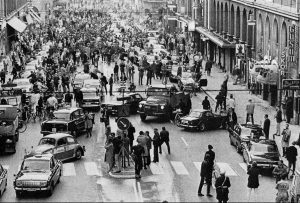 with only a handful serious. On the Monday following Dagen H, there were 125 reported traffic accidents, compared to a range of 130 to 198 for previous Mondays, none of them fatal. Experts suggested that changing to driving on the right reduced accidents while overtaking, as people already drove left-hand drive vehicles, giving them a better view of the road ahead. In addition, the change caused an increase in perceived risk and so was followed by very cautious behavior that caused a major decrease in road fatalities. Fatal car-to-car and car-to-pedestrian accidents dropped sharply, and the number of auto insurance claims went down by 40%. While all this was a good change, for a short time on that day, this was a serious traffic jam.
with only a handful serious. On the Monday following Dagen H, there were 125 reported traffic accidents, compared to a range of 130 to 198 for previous Mondays, none of them fatal. Experts suggested that changing to driving on the right reduced accidents while overtaking, as people already drove left-hand drive vehicles, giving them a better view of the road ahead. In addition, the change caused an increase in perceived risk and so was followed by very cautious behavior that caused a major decrease in road fatalities. Fatal car-to-car and car-to-pedestrian accidents dropped sharply, and the number of auto insurance claims went down by 40%. While all this was a good change, for a short time on that day, this was a serious traffic jam.

 Prior to 1956, the road and highway system in the United States, well…lets just say, it left something to be desired…like passable roads for instance. Yes, there were a few highways, but on June 29, 1956, President Dwight Eisenhower signed the Federal-Aid Highway Act of 1956. This bill changed the highways by creating a 41,000-mile “National System of Interstate and Defense Highways” that would, according to Eisenhower, eliminate unsafe roads, inefficient routes, traffic jams and all of the other things that got in the way of “speedy, safe transcontinental travel.” At the same time, highway advocates argued, “in case of atomic attack on our key cities, the road net [would] permit quick evacuation of target areas.” The 1956 law, which allocated more than $30 billion for the construction, declared that the construction of an elaborate expressway system was “essential to the national interest.” The plan included a lot of discussion on things like where exactly the highways should be built, and how much of the cost should be carried by the federal government versus the individual states. Several competing bills went through Congress before 1956, like the ones spearheaded by the retired general and engineer Lucius D Clay, Senator Albert Gore Sr, and Representative George H Fallon, who called his program the “National System of Interstate and Defense Highways,” thereby linking the nationwide construction of highways with the preservation of a strong national defense.
Prior to 1956, the road and highway system in the United States, well…lets just say, it left something to be desired…like passable roads for instance. Yes, there were a few highways, but on June 29, 1956, President Dwight Eisenhower signed the Federal-Aid Highway Act of 1956. This bill changed the highways by creating a 41,000-mile “National System of Interstate and Defense Highways” that would, according to Eisenhower, eliminate unsafe roads, inefficient routes, traffic jams and all of the other things that got in the way of “speedy, safe transcontinental travel.” At the same time, highway advocates argued, “in case of atomic attack on our key cities, the road net [would] permit quick evacuation of target areas.” The 1956 law, which allocated more than $30 billion for the construction, declared that the construction of an elaborate expressway system was “essential to the national interest.” The plan included a lot of discussion on things like where exactly the highways should be built, and how much of the cost should be carried by the federal government versus the individual states. Several competing bills went through Congress before 1956, like the ones spearheaded by the retired general and engineer Lucius D Clay, Senator Albert Gore Sr, and Representative George H Fallon, who called his program the “National System of Interstate and Defense Highways,” thereby linking the nationwide construction of highways with the preservation of a strong national defense.
For President Eisenhower, however, who had participated in the United States Army’s first transcontinental motor convoy in 1919, during World War II, there was a realization that the country needed a better highway system. He had seen Germany’s Autobahn network, and admired the efficiency of it. In January 1956, Eisenhower repeated his 1954 State of the Union address call for a “modern, interstate highway system.” Later that month, Fallon introduced a revised version of his bill as the Federal Highway Act of 1956. It provided for a 41,000 mile national system of interstate and defense highways to be built over 13 years, with the federal government paying for 90 percent, or $24.8 billion. To raise funds for the project, Congress increased the gas tax from two to three cents per gallon and impose a series of other highway user tax changes. On June 26, 1956, the Senate approved the final version of the bill by a vote of 89 to 1. Senator Russell Long, who opposed the gas tax increase, cast the single “no” vote. That same day, the House approved the bill by a voice vote, and three days later, Eisenhower signed it into law.
The highway construction began almost immediately. With the construction came the employment of tens of thousands of workers and the use of billions of tons of gravel and asphalt. The system fueled a surge in the interstate trucking industry. That was good, but soon it pushed aside the railroads to gain the lion’s share of the domestic shipping market. Interstate highway construction also fostered the growth of roadside businesses such as restaurants, most of which were fast-food chains, hotels and amusement parks. By the 1960s, an estimated one in seven Americans was employed directly or indirectly by the automobile industry. Not only 
 that, but America had become a nation of drivers. Legislation has extended the Interstate Highway Revenue Act three times. Many historians say it is Eisenhower’s greatest domestic achievement. Many called the years between 1956 and 1966 “the Greatest Decade.” Still, critics of the system have pointed to its less positive effects, including the loss of productive farmland and the demise of small businesses and towns in more isolated parts of the country. I suppose that’s true, but it was inevitable.
that, but America had become a nation of drivers. Legislation has extended the Interstate Highway Revenue Act three times. Many historians say it is Eisenhower’s greatest domestic achievement. Many called the years between 1956 and 1966 “the Greatest Decade.” Still, critics of the system have pointed to its less positive effects, including the loss of productive farmland and the demise of small businesses and towns in more isolated parts of the country. I suppose that’s true, but it was inevitable.
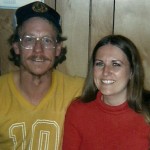 It’s funny, how time changes people. When our daughters, Corrie Schulenberg Petersen and Amy Schulenberg Royce, were little, we lived on a place east of Casper. We had a well, septic system, and our home was heated by propane. All that didn’t matter to the girls, and when they were little, they didn’t mind living in the country. I suppose it was just normal, and having all that space was a nice thing for them. They could ride their bicycles all over the place, and there were friends near enough for them to have playmates. For kids with no place to go exactly, the whole thing was just fine. Bob and I liked it too during those years. Of course, when we started bowling…like every day, living in the country wasn’t quite as convenient. We were I town all the time. In fact, my sister, Alena Stevens told me once that we weren’t country people…we were city people who slept in the country. She was right, of course. It wasn’t too long before we began to think about moving to town….but I’m getting a little ahead of myself.
It’s funny, how time changes people. When our daughters, Corrie Schulenberg Petersen and Amy Schulenberg Royce, were little, we lived on a place east of Casper. We had a well, septic system, and our home was heated by propane. All that didn’t matter to the girls, and when they were little, they didn’t mind living in the country. I suppose it was just normal, and having all that space was a nice thing for them. They could ride their bicycles all over the place, and there were friends near enough for them to have playmates. For kids with no place to go exactly, the whole thing was just fine. Bob and I liked it too during those years. Of course, when we started bowling…like every day, living in the country wasn’t quite as convenient. We were I town all the time. In fact, my sister, Alena Stevens told me once that we weren’t country people…we were city people who slept in the country. She was right, of course. It wasn’t too long before we began to think about moving to town….but I’m getting a little ahead of myself.
As the girls became teenagers, and began driving and dating, the whole thing about living in the country…well,  the girls didn’t like it so much anymore. The long distance to town became an annoyance to them, and in the Winter months, the roads…which were awful, made for a treacherous drive both morning and night. Their boyfriends weren’t too keen on coming all the way out there to pick them up, but I must say, that Corrie’s husband, Kevin was a pretty good sport about it. Still with both future husbands, there were many times when dates took place after the girls got off work, and that meant that they had to drive themselves home afterward. I think it was about the time that the girls started driving, that I began to see that living in the country was not always sunshine and wide open spaces. There was a lot of dangers that my girls had to face on those drives home, and I don’t think I would have survived those years, had it not been for prayer and God’s angels to watch over my babies. We had taught them how to drive, and what to do to be safe, but when you turn your girl loose to drive home at midnight, you need the angels out there with them. That’s all there is to it.
the girls didn’t like it so much anymore. The long distance to town became an annoyance to them, and in the Winter months, the roads…which were awful, made for a treacherous drive both morning and night. Their boyfriends weren’t too keen on coming all the way out there to pick them up, but I must say, that Corrie’s husband, Kevin was a pretty good sport about it. Still with both future husbands, there were many times when dates took place after the girls got off work, and that meant that they had to drive themselves home afterward. I think it was about the time that the girls started driving, that I began to see that living in the country was not always sunshine and wide open spaces. There was a lot of dangers that my girls had to face on those drives home, and I don’t think I would have survived those years, had it not been for prayer and God’s angels to watch over my babies. We had taught them how to drive, and what to do to be safe, but when you turn your girl loose to drive home at midnight, you need the angels out there with them. That’s all there is to it.
Then came the time when we decided that country living wasn’t all it had been cracked up to be when the girls were little. Unfortunately for Corrie, the final decision to move to town came after her marriage…much to her  dismay. And in reality, it came only eight months before Amy’s marriage to Travis. Once we moved to town, I found myself really back in my element again, because I had been raised in Casper, after all. Bob was raised in the country, but he adapted to living in town like a man who had never lived a day of his life in the country. Corrie and Kevin live in Casper too, as did Amy and Travis before their move to Washington. Now, strangely, as they have purchased their home in Ferndale, Washington…or should I say ten minutes outside Ferndale, Amy and Travis…or at least Amy, has come full circle, and is living in the country again. Travis, like me, was raised in the city. Nevertheless, they will quickly get a handle on the whole country living thing…complete with a well, septic system, and propane. How strange is that?
dismay. And in reality, it came only eight months before Amy’s marriage to Travis. Once we moved to town, I found myself really back in my element again, because I had been raised in Casper, after all. Bob was raised in the country, but he adapted to living in town like a man who had never lived a day of his life in the country. Corrie and Kevin live in Casper too, as did Amy and Travis before their move to Washington. Now, strangely, as they have purchased their home in Ferndale, Washington…or should I say ten minutes outside Ferndale, Amy and Travis…or at least Amy, has come full circle, and is living in the country again. Travis, like me, was raised in the city. Nevertheless, they will quickly get a handle on the whole country living thing…complete with a well, septic system, and propane. How strange is that?
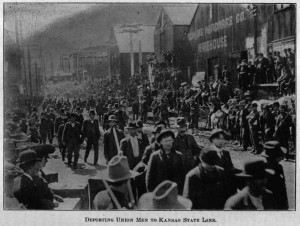 I think a lot of people know or at least have heard of Cripple Creek, Colorado. Most people think of the fourteen casinos located there, and I suppose that casinos are a fitting thing for Cripple Creek to be known for, but it wasn’t always that way. Cripple Creek became a gold mining boom town in 1894 after gold was discovered there. At that time 150 gold mines suddenly sprang up, and with them, a strong miners union…the Free Coinage Union Number 19, which was a part of the militant Western Federation of Miners.
I think a lot of people know or at least have heard of Cripple Creek, Colorado. Most people think of the fourteen casinos located there, and I suppose that casinos are a fitting thing for Cripple Creek to be known for, but it wasn’t always that way. Cripple Creek became a gold mining boom town in 1894 after gold was discovered there. At that time 150 gold mines suddenly sprang up, and with them, a strong miners union…the Free Coinage Union Number 19, which was a part of the militant Western Federation of Miners.
As with any gold mining operation, desparate workers began pouring in from all over the country. Before long Cripple Creek had a huge labor surplus. With the labor surplus, the owners begin requiring extra hours, with no pay increase, or the alternative, they could keep the current 8 hours a day with a pay reduction of 50 cents. The Western Federation of Miners opposed both plans, and the miners when on strike. Their picket lines and refusal to work closed most of the mines. They showed what solidarity is all about. The miners who were still going down in the 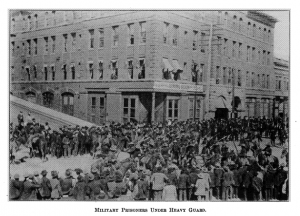 working mines assessed themselves 10 percent of their wages to support the strikers, and the union set up soup kitchens. How often to you see people who can’t afford to strike, but who are willing to support those who do strike.
working mines assessed themselves 10 percent of their wages to support the strikers, and the union set up soup kitchens. How often to you see people who can’t afford to strike, but who are willing to support those who do strike.
The governer of Colorado, David Waite would not help the labor bosses, but they had the county Sheriff, Frank Bowers in their pocket. They told the miners to go back to work, they would not. By the end of October, things had gotten so out of hand that finally, on November 23, 1903, Governor Peabody agreed to send the state miltia to protect replacement workers that the bosses had brought in. The striking miners were furious and they barricaded the roads and railways. The soldiers began rounding up the union members and their sympathizers, including the entire staff of a pro-union newspaper, and imprisoned them without charges or any evidence that they had done anything wrong.
The miners and others who were imprisoned complained that their constitutional rights had been violated, and 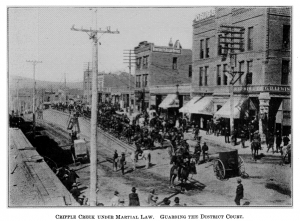
one anti-union judge replied, “To hell with the Constitution; we’re not following the Constitution!” Those tactics brought out the more radical elements of the Western Federation of Miners, and in June of 1904 Harry Orchard, who was a professional terrorist the the union employed, blew up a railroad station, whick killed 13 strikebreakers. With the bombing came the outrage of the public and the deportation of the Western Federation of Miners leaders. By midsummer, the strike was over and the Western Federation of Miners never regained the same level of power it had originally had in the Colorado mining districts. Even in this day and age, the unions and the bosses seem to always be at odds, and I suppose that something like this could happen again.
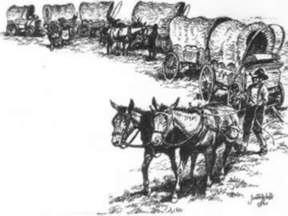 This summer when Bob and I were in the Black Hills, we were looking around in the gift shop at Mount Rushmore, when I came across a book called “Women’s Diaries Of The Westward Journey.” Since then, I have been thinking about what it must have been like to travel in a covered wagon…especially for a woman. Of course, times were different back then, and people did not have the luxury of a daily shower, or even a real bathroom…and that was in their own homes. So, imagine what life would be like on a wagon, traveling in a wagon train headed west in the mid-1800s. As the emigrants were traveling west, they were making their own roads, hunting their own food, and cooking over a campfire. For a lot of people, I’m sure this sounds like going camping, but then imagine doing it for months at a time. A day’s travel averaged about twelve to twenty miles, meaning that on the plains, they often stopped for the day within sight of the site they had just left that morning. For travelers now, that would seem insanely slow, but for the wagon trains, it was just the normal day’s journey. They knew no other way.
This summer when Bob and I were in the Black Hills, we were looking around in the gift shop at Mount Rushmore, when I came across a book called “Women’s Diaries Of The Westward Journey.” Since then, I have been thinking about what it must have been like to travel in a covered wagon…especially for a woman. Of course, times were different back then, and people did not have the luxury of a daily shower, or even a real bathroom…and that was in their own homes. So, imagine what life would be like on a wagon, traveling in a wagon train headed west in the mid-1800s. As the emigrants were traveling west, they were making their own roads, hunting their own food, and cooking over a campfire. For a lot of people, I’m sure this sounds like going camping, but then imagine doing it for months at a time. A day’s travel averaged about twelve to twenty miles, meaning that on the plains, they often stopped for the day within sight of the site they had just left that morning. For travelers now, that would seem insanely slow, but for the wagon trains, it was just the normal day’s journey. They knew no other way.
People back then would have been somewhat crazy to set out alone for the west…or to set out any later than spring, because either scenario was bound to fail. They needed the protection of the wagon train, as well as the 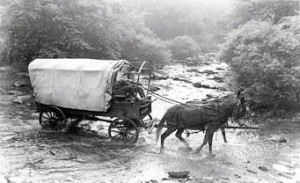 additional supplies, should a wagon be lost to fire, a river crossing, or an attack by Indians. It was their back up plan. They couldn’t just stop at the next town at a store and buy more supplies. There were no towns, stores, or even roads. When we travel, even in the rural state of Wyoming that I live in, we are used to seeing miles with very little to catch the eye, other that an occasional farm house, and an occasional town, but remember that we have roads to follow so we don’t lose our way. And even then, many of us use GPS to make sure we are taking the right road. They had none of that. They had to use the sun and landmarks to make sure they were going the right direction. They depended on people who had taken this trip before them. It was all they had. I think most of us today would go nuts if we never saw a house, a road, or a town. We would wonder if we were insane for setting out on this crazy adventure at all. One woman wrote to her husband, who was waiting at the end of the line, with the spelling ability she had at the time, “I can tell you nothing only that were hear and its strange I wish we had never started … it seems impossible to get their.” She had set out in a wagon train with her four children, without her husband, and that in itself must have been scary.
additional supplies, should a wagon be lost to fire, a river crossing, or an attack by Indians. It was their back up plan. They couldn’t just stop at the next town at a store and buy more supplies. There were no towns, stores, or even roads. When we travel, even in the rural state of Wyoming that I live in, we are used to seeing miles with very little to catch the eye, other that an occasional farm house, and an occasional town, but remember that we have roads to follow so we don’t lose our way. And even then, many of us use GPS to make sure we are taking the right road. They had none of that. They had to use the sun and landmarks to make sure they were going the right direction. They depended on people who had taken this trip before them. It was all they had. I think most of us today would go nuts if we never saw a house, a road, or a town. We would wonder if we were insane for setting out on this crazy adventure at all. One woman wrote to her husband, who was waiting at the end of the line, with the spelling ability she had at the time, “I can tell you nothing only that were hear and its strange I wish we had never started … it seems impossible to get their.” She had set out in a wagon train with her four children, without her husband, and that in itself must have been scary.
Days on the wagon train began long before dawn with a simple breakfast of coffee, bacon, and dry bread. After breakfast, the people secured their supplies, hitched up their teams, and hit the trail by seven o’clock in the morning. Most people walked because of lack of space, and the fact that the wagon was so uncomfortable. The 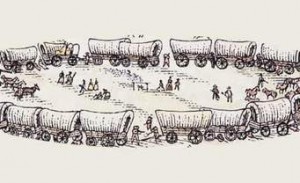 train stopped at noon for a cold meal of coffee, beans, and bacon, which had been prepared that morning. During this break, called nooning, men and women would gather and talk, children would play, and animals would rest. After that, the travel would continue until around six o’clock in the evening, when they wagons would circle for the night. Some people would visit after supper, but most went to bed, because they were exhausted. Some slept in the wagon, but most slept on the ground, because oddly enough it was more comfortable. While traveling west on the wagon trains was a necessary journey to be made to grow this country, it was not an easy journey to make, and for that reason, I have to stand in awe of those who did it.
train stopped at noon for a cold meal of coffee, beans, and bacon, which had been prepared that morning. During this break, called nooning, men and women would gather and talk, children would play, and animals would rest. After that, the travel would continue until around six o’clock in the evening, when they wagons would circle for the night. Some people would visit after supper, but most went to bed, because they were exhausted. Some slept in the wagon, but most slept on the ground, because oddly enough it was more comfortable. While traveling west on the wagon trains was a necessary journey to be made to grow this country, it was not an easy journey to make, and for that reason, I have to stand in awe of those who did it.

 When a young couple gets married, their hopes and dreams, and those of their families, is that they will live the storybook life of happily ever after. All too often, these days anyway, that ends up not being the case. Nevertheless, my dear husband, Bob Schulenberg and I have managed to beat the odds, and today we stand here together, rejoicing as we celebrate forty years of love. Looking back, I have sometimes wondered how we did it. There are probably hundreds of people who would give you advise on how to make your marriage last, but I have to say that there is no set way, no clear reason, no perfect formula to keeping a marriage together, because each marriage is as unique as it’s parts…the couple themselves. What works for one may not work for another. Marriages that seem doomed because they do everything different than the formulas out there, make it, while those that seem to be perfect crumble under the pressures of everyday life.
When a young couple gets married, their hopes and dreams, and those of their families, is that they will live the storybook life of happily ever after. All too often, these days anyway, that ends up not being the case. Nevertheless, my dear husband, Bob Schulenberg and I have managed to beat the odds, and today we stand here together, rejoicing as we celebrate forty years of love. Looking back, I have sometimes wondered how we did it. There are probably hundreds of people who would give you advise on how to make your marriage last, but I have to say that there is no set way, no clear reason, no perfect formula to keeping a marriage together, because each marriage is as unique as it’s parts…the couple themselves. What works for one may not work for another. Marriages that seem doomed because they do everything different than the formulas out there, make it, while those that seem to be perfect crumble under the pressures of everyday life.
I have talked to many people over the years who told me that they were shocked that we were still together, because when we got married, they simply didn’t expect it to last. Nevertheless, we have never considered the thought of not being together. Bob is my other half, and I am his. Through thick and thin, that fact has never changed. We are complete in each other. I suppose that maybe that could be considered marital advise, and maybe it is…I don’t know, but I do know that I just never felt like we were anything else but, two halves of a whole person. Fights don’t matter, stress doesn’t matter, and troubles don’t matter. It’s love that matters.
I can’t think of a better man to walk the roads I have walked, than Bob. He is there to help me with the things I need to do, and support me in my hopes and dreams. They may be different than his, but we would be boring if they weren’t. We both have different abilities and different talents, but when put together, we compliment each other very well. He is my helper, and I am his. We depend on each other, and we never let the other down. I don’t know what I would have done without him…especially these last ten years, while taking care of our parents, and sister-in-law, for a short time. He has been my right hand man, even if he is left handed.
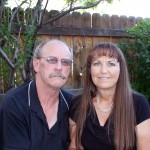

No marriage has a magic formula for perfection. Each is unique, and each will only last if both parties are determined to make it last. Bob and I were blessed. We could not have made it if God hadn’t been there…leading and guiding us every step of the way. Praise God for His guidance. Today, Bob and I celebrate forty years of wedded bliss. Bob, I love you more with each passing year. You truly are the love of my life. Happy 40th Anniversary Bob!! Here’s to forty more years of happiness. I love you…forever and always!!
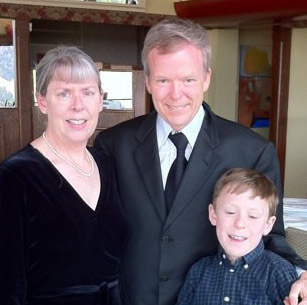 I have been intently watching the flooding this past week in Colorado, and especially Boulder, which is very near where my cousin Tim and his family live. Rain has poured into the state, and the flooding rivals the July 31, 1976 Big Thompson flood in many areas. In that flood, 12 to 14 inches of rain fell in 4 hours, flooding the canyon…144 people lost their lives, and 150 were injured. So far in this flood, only 4 people have died, thankfully, and hopefully that will be all, but only time will tell. Roads have been washed out, and I-25 is under water in some areas, causing it’s closure along with the closure of many other roads. Neighbors have stepped up to help save the homes of other people, some of whom they don’t even know, and often working for hours without even being asked. It has been a real show of the human spirit and its ability to care for those in need. Outside help is probably scarce, because no one can get there, leaving them somewhat isolated, except for helicopters that have been able to come in from other areas. Schools are closed, and many people have been told not to attempt to go to work. Two people were
I have been intently watching the flooding this past week in Colorado, and especially Boulder, which is very near where my cousin Tim and his family live. Rain has poured into the state, and the flooding rivals the July 31, 1976 Big Thompson flood in many areas. In that flood, 12 to 14 inches of rain fell in 4 hours, flooding the canyon…144 people lost their lives, and 150 were injured. So far in this flood, only 4 people have died, thankfully, and hopefully that will be all, but only time will tell. Roads have been washed out, and I-25 is under water in some areas, causing it’s closure along with the closure of many other roads. Neighbors have stepped up to help save the homes of other people, some of whom they don’t even know, and often working for hours without even being asked. It has been a real show of the human spirit and its ability to care for those in need. Outside help is probably scarce, because no one can get there, leaving them somewhat isolated, except for helicopters that have been able to come in from other areas. Schools are closed, and many people have been told not to attempt to go to work. Two people were 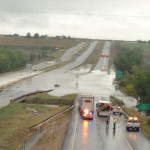 stranded in the mountains in whiteout conditions, because
stranded in the mountains in whiteout conditions, because 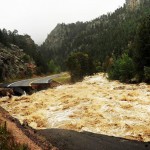 rescue resources were limited. They were rescued after 48 hours in the storm. Tim told me that the barrel they have in their back yard, to measure the rain, shows 10 inches over 3 days, with most of it coming over a 12 hour period. The huge snow storm in the mountains could cause continuing problems if it begins to melt.
rescue resources were limited. They were rescued after 48 hours in the storm. Tim told me that the barrel they have in their back yard, to measure the rain, shows 10 inches over 3 days, with most of it coming over a 12 hour period. The huge snow storm in the mountains could cause continuing problems if it begins to melt.
This flood also reminded me of an old photograph in my grandmother’s album. I’m not sure where this taken, but it does appear that they had quite a bit of water. Sadly, in those days, homes weren’t sealed as well, and so I’m sure there was extensive damage. Add to that, the fact that they didn’t have some of the clean up tools and chemicals to prevent mold, and you have a recipe for a big mess. They also didn’t have warning systems to tell them of the possiblity of a flash flood, and there were may people who lost their lives in 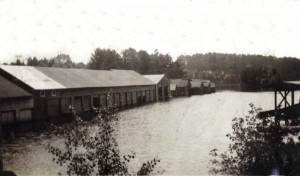 those situations. The things that have not changed over the years are the incredible human spirit and peoples’ will to survive. Neighbors will continue to help their neighbors, and people will fight to survive and rebuild their lives after each new disaster hits them. Floods are one of the most dangerous situations people can be in, and I am thankful that we have resources today to help more and more of them survive that danger. I will continue to pray for all those people who’s lives have been touched by the 2013 Colorado floods.
those situations. The things that have not changed over the years are the incredible human spirit and peoples’ will to survive. Neighbors will continue to help their neighbors, and people will fight to survive and rebuild their lives after each new disaster hits them. Floods are one of the most dangerous situations people can be in, and I am thankful that we have resources today to help more and more of them survive that danger. I will continue to pray for all those people who’s lives have been touched by the 2013 Colorado floods.

